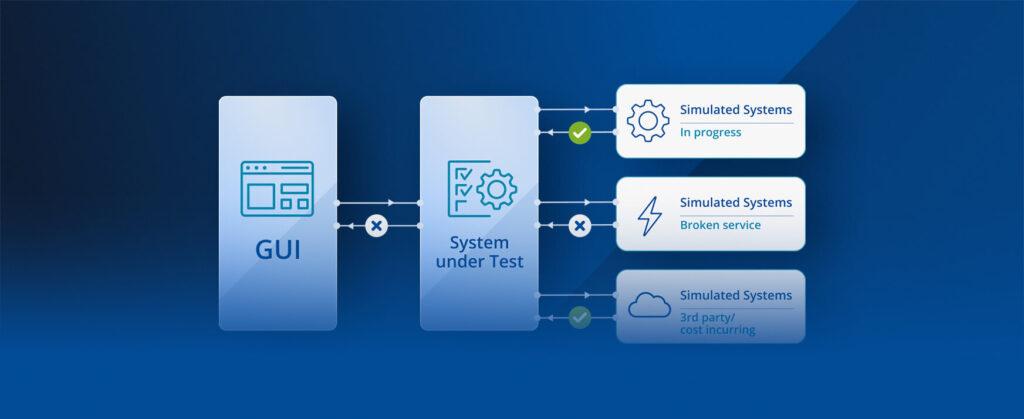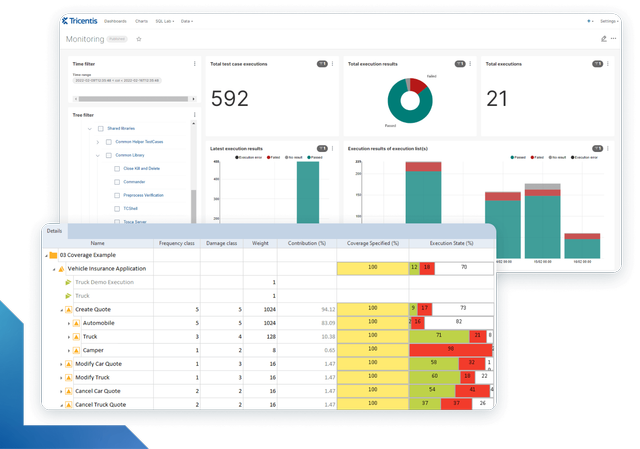Service virtualization 2.0 with Tricentis API Simulation
Tricentis API Simulation boosts early testing, cuts costs, and enables continuous development by simulating APIs and reducing dependencies.

Service virtualization, which gained prominence in 2012, has significantly transformed the way software testing and development are approached. Originally designed to address limited access to dependent systems during development, service virtualization has evolved into a critical technology for enabling efficient and continuous testing. This blog explores its origins, key advancements over the past decade, ongoing challenges, and how API simulation is shaping the future of testing.
The early days of service virtualization
Service virtualization emerged to solve a recurring problem in software development — how to continue testing when key systems or services are unavailable, incomplete, or too costly to use. By simulating the behavior of these services, teams could proceed with development without waiting for full access to the actual systems.
In its early stages, service virtualization primarily benefitted quality engineers by enabling early testing. However, limitations soon became apparent. Service virtualization tools were designed for testers, but they could have been even more beneficial for developers or system architects if applied earlier in the development lifecycle.
Key advancements in the last decade
Since its inception, service virtualization has undergone significant advancements:
- Scalability: Early virtualization tools could only simulate a few basic services. Today, modern platforms can handle thousands of virtual services simultaneously, supporting large-scale enterprise needs and providing extensive access to virtual environments.
- AI and automation integration: The integration of artificial intelligence (AI) into service virtualization has been a game-changer. AI can generate virtual services and predict the behavior of real services based on historical data. While AI adds value, it still faces limitations when applied to vast, complex enterprise systems.
- Cloud-based solutions: Moving service virtualization to the cloud has had a profound impact. By hosting virtual environments on the cloud, teams can access simulations from anywhere, reducing the need for local infrastructure and increasing flexibility.
Challenges in service virtualization today
Despite these advancements, challenges remain. One major issue is that many service virtualization tools are still primarily aimed at quality engineers, even though developers or system architects are often better suited to creating the first set of virtual services. The technical intricacies involved in simulating complex services require domain expertise beyond the scope of traditional QA teams.
Additionally, scaling service virtualization for large enterprises presents significant hurdles. While AI and machine learning are often promoted as solutions, they fall short when applied at scale in real-world enterprise environments. Automation plays a role, but truly scalable solutions require deeper integration across development and testing workflows.
Reimagining service virtualization
Recently, I had the unique opportunity to rethink service virtualization from the ground up, leveraging modern technologies. This was an exciting challenge that made me question the foundational elements of how service virtualization should work in today’s rapidly evolving development landscape.
One key realization was that we need to build virtualization technology that not only works for QA teams but also excites developers. Imagine virtualization technology where developers can mock services as code early in the app development process. These mock services could then easily integrate into a larger, more comprehensive virtual environment used for testing by non-technical teams. This would foster better collaboration and ensure that virtual services could scale across an organization without requiring a deep understanding of the underlying systems.
Enter Tricentis API Simulation
As yet another innovative feature delivered through Tricentis Tosca’s cloud capabilities, Tricentis API Simulation represents a breakthrough in service virtualization, allowing teams to simulate APIs and create virtual test environments that are independent of unavailable or costly services. It empowers developers to perform early-stage testing while integrating smoothly into broader test automation strategies, ensuring quality from the outset.
Key benefits include:
- Eliminate testing delays: API Simulation allows teams to simulate dependent components that may not yet be available, ensuring continuous development without interruptions.
- Reduce costs: By virtualizing complex and expensive API services, organizations can cut down on infrastructure and testing overhead costs.
- Continuous testing: With stable access to virtualized environments, teams can conduct continuous testing without waiting for dependent systems to become available.
- Early detection of issues: API Simulation enables contract testing, allowing teams to detect API issues before they affect the broader system, reducing risks early in the development cycle.
- Cross-team collaboration: Developers can create mock services as code, which can then be used by QA teams for load and functional testing, fostering better collaboration across departments.
The future of API Simulation
As service virtualization continues to evolve, Tricentis API Simulation is leading the way toward more integrated, cross-functional testing processes. This technology enables developers to work confidently, knowing that complex systems can be built and deployed without reliance on real infrastructure or dependent services.
Tricentis API Simulation is at the forefront of this transformation, helping to redefine how teams approach testing and development. By empowering both developers and QA teams to collaborate and simulate services seamlessly, API Simulation is driving the industry closer to achieving true continuous testing.
To learn more, join us for an upcoming webinar, “Reduce testing costs for gen AI and test environments with Tosca’s next-gen API simulation.”
If you would like to see it in action sooner, you can request a demo here.
